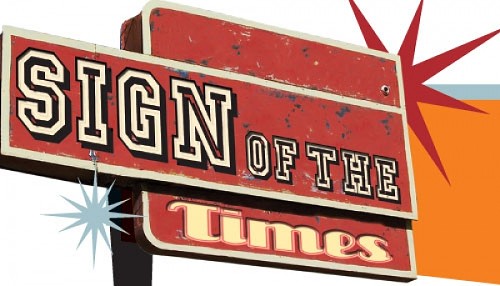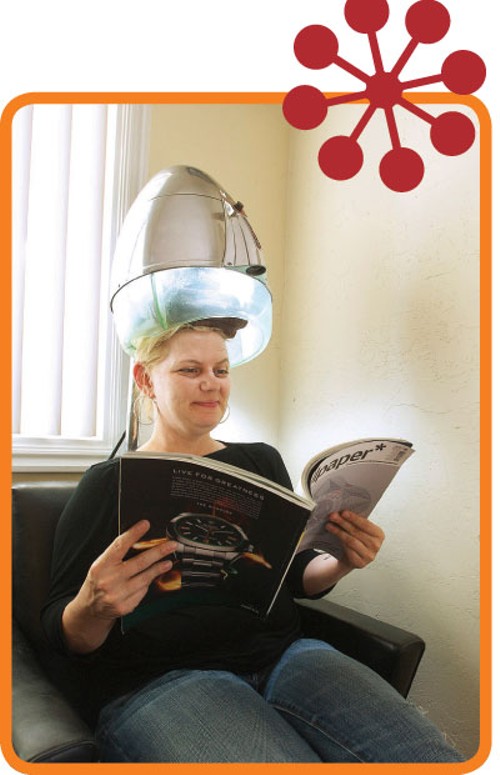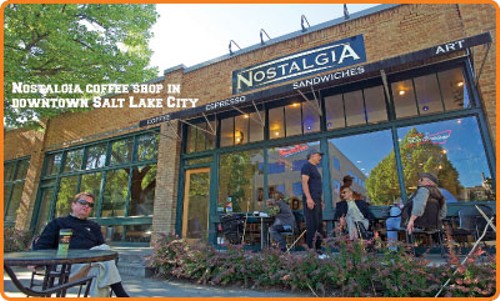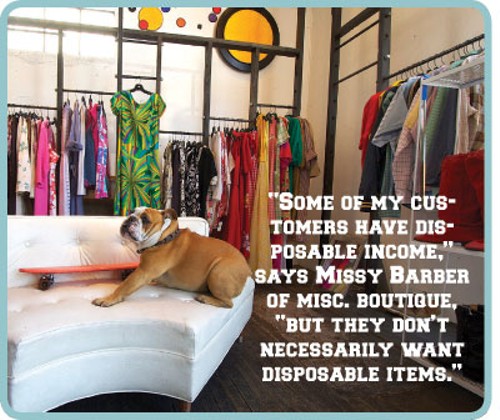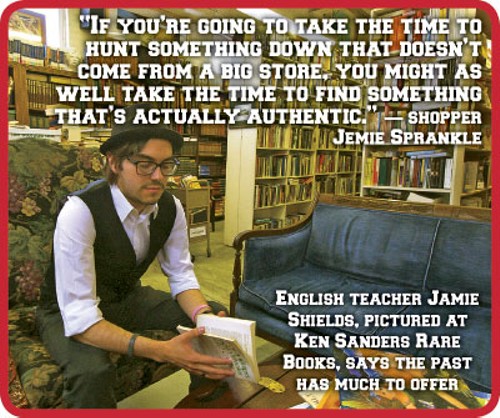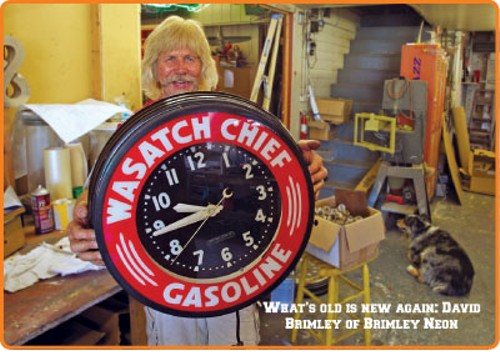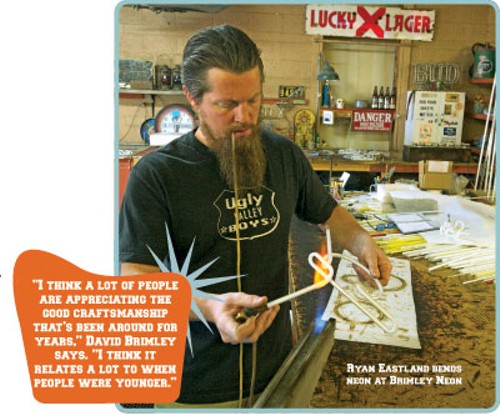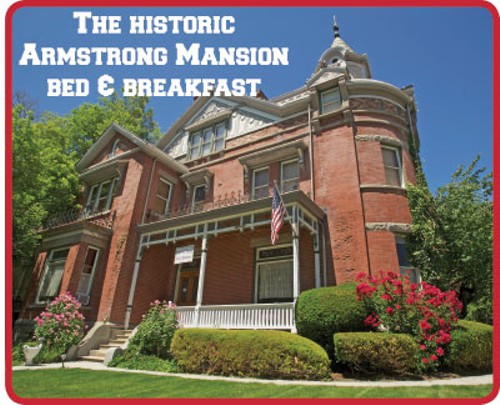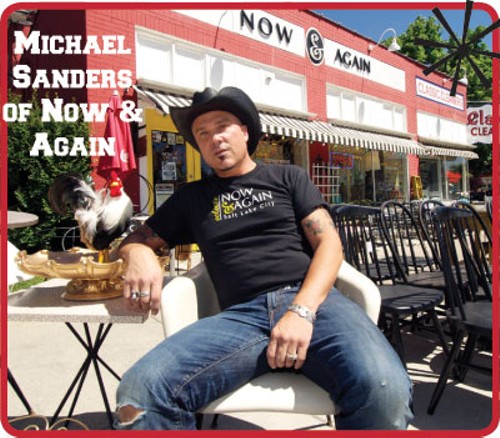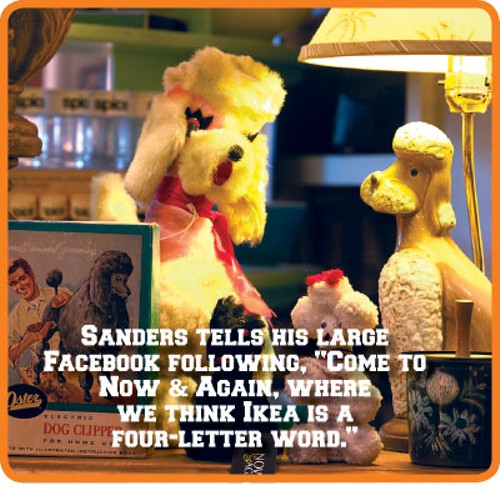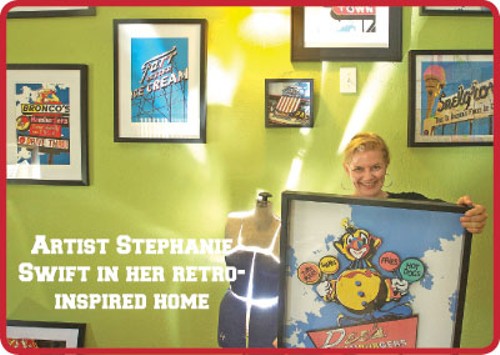You know that guy—or maybe you are that guy—who occasionally has to push-start his old Volkswagen bus before it goes sputtering down the road. Even though a brand-new car is just a measly down payment and a small monthly installment away from your driveway, you refuse to relegate that VW to the salvage yard because the odometer reflects so much of you and your epic road trips—plus, you just like the way you feel when driving it.
Or maybe you dust off your mother’s old green electric frying pan once in a while for a taste of her fried chicken that she whipped up when you were a kid. For you, it’s less about filling your gut with a piece of deep-fried chicken than it is about keeping alive that particular dying culinary process and recapturing, in a single meal, the memory of your mother.
It’s called nostalgia—people clinging white-knuckled to the past.
Many of us desire to stay connected to the past in some way. For some, that connection nourishes an emotional need, often associated with a time or place in life when the living was simpler, easier and sunnier.
Others court the nostalgic side of life as they mutter to themselves, “They don’t make ’em like they used to.” That doesn’t make them wrinkly curmudgeons. Rather, these are consumers of all ages who want something with character that will last, or at least be worth the effort to make it last.
University of Utah family and consumer-studies professor emeritus John Burton uses his spare time these days to rescue relics from yard sales.
“Sometimes you’re buying nostalgia when buying the product itself,” Burton says, like the old Erector set he and a friend found while sifting through the detritus of yet another sale.
“I’m buying it to bring me back to my childhood,” Burton explains. “It reminds me of a time when I could build things, to build toys I didn’t have.”
Burton also targets old carpenter tools that he uses himself or handmade items that once meant something to someone. He has a son who keeps a ’94 Toyota 4Runner running at great expense because of the memories it holds.
Burton, 74, has a group of friends who, when they get talking about their first cars, wax nostalgic till they can practically see themselves—their younger selves—in the shine of those conversations.
“It’s a guy thing,” he says. “You will have all kinds of nostalgia about this car or that. … We had an emotional connection to our vehicles, partly because we had to spend so much time keeping the damned things running. We understood what it took to make them run. They were simpler then.”
He cuts himself short before going into too much detail about the emotional connection to what went on in the bench-style backseats of those cars.
Analog Past
So, are we in the middle of a nostalgia movement?
Maybe.
Burton says his general observation is that there seems to be more and more consignment stores popping up these days, dealing daily in nostalgia, intentionally or otherwise.
JWT Intelligence is part of a New York City-based marketing communication company that watches consumer trends, noting on its website how adults are increasingly buying classic toys like Lego products, Mega Bloks and Tinkertoys. JWT writer Alec Foege points out that the recession drove some of that increase.
“There’s been a steady sales increase in old-fashioned building-block toys since 2007, due in part to adults fondly recalling their own youth,” Foege writes. “Major licensing deals are also roping in adults nostalgic for franchises that hark back to their youth, such as Lego’s Star Wars and Lord of the Rings lines.”
As JWT pointed out in its video spot “10 Trends for 2012 in 2 Minutes,” consumers are buying things as a means to connect with or keep in touch with their “analog past.”
Stephanie Swift keeps five dusty accordions, an old-school salon hair dryer, a full set of aged bowling pins and several hip, old chairs in her Murray home.
“You see the stuff, and it makes you happy,” Swift says.
No, she doesn’t play the accordion, let alone bowl inside her home. She does sit in the chairs, though.
Oh, and she has a friend who owns over 300 elderly toasters. Toast, anyone?
But Swift hits on the very thing that drives many who flirt with nostalgia: Happiness. And we all want it.
The artist in Swift, a graphic designer by trade, locked into that basic need with her quirky works about five years ago.
She loved taking pictures of old signs, so she parlayed her design skills into making art out of the photos. Swift’s sister urged her to enter the work into an arts festival. Bam. She was discovered.
Swift estimates she’s sold more than 1,000 framed and unframed pieces of her unique art, which taps into a happiness vein.
Her work (PrettyLittlePixel.com, see p. 18) has won two City Weekly Best of Utah awards and been featured at arts festivals in Salt Lake City, Fort Worth and Omaha, where recently she sold hundreds of pieces.
A common theme has flowed among her buyers from the start. “Everyone had a story,” Swift says. “It’s all about the story”:
They met at Bill and Nada’s. They got thrown out of Bar-X. They spent the night at the Scenic Motel (RIP—the landmark’s sign on Foothill Boulevard is gone). Their dad took them to Snelgrove’s when they were kids.
“That’s when I thought, ‘Oh, shit,’ ” Swift says about realizing what she discovered about her photos of old signs.
Brian Webb channeled the feeling when he named his coffee shop, on 100 South, Nostalgia.
When Webb and his wife at the time were considering names for their business, they recalled the good feelings that an old Salt Lake City coffee shop gave them.
“Basically, it brought back the history of how her and I met,” Webb says inside his coffee shop.
The marriage went south, but Nostalgia lives on.
“I think people come to this place and feel the positive vibe,” Webb says. “It’s like their second home, or their home away from home. Everybody loves the atmosphere.”
Webb says that in 10 years or so, couples who might have met at Nostalgia will one day feel that same feeling that is closely associated with a sense of place and, in this case, the aroma of hot water filtered through coffee grounds.
Just as a smell or taste can trigger a powerful nostalgic feeling, so too can a once-forgotten frock from Grandma’s closet.
Missy Barber has made a business for the past three years out of selling wearable used vintage clothing at misc. boutique in Salt Lake City. Her specialty eras are the 1950s through the ’70s.
She’ll visit small towns in Idaho and Oregon or even go poking around Florida in search of well-made, preserved items she thinks will sell. She fantasizes about a cross-country trip that revolves around her deeply rooted interest and love for things that are “beyond my time,” gathering items along the way to resell in her store.
Barber sees a lot of return customers, most in their 20s and a few in their 70s.
“They want something that is going to last and that doesn’t look like everything else,” Barber says.
So much today, she adds, is made to throw away when it wears out or breaks down just months after being purchased. These disposable (sometimes cheaper, sometimes more expensive) clothing and other goods are as close as your nearest big-box store, which, no matter how big a nostalgia movement gets, won’t be going anywhere anytime soon.
So how do these smaller shops, with their smaller inventories, make it work in the shadow of Target, H&M and Forever 21?
“I’m making enough money to live on,” Barber says. “I consider that a success in this economy.”
And she’ll be ready when—whether you’re rich, poor or just frugal—you’re ready for the switch to quality vintage.
“Some of my customers have disposable income,” she says, “but they don’t necessarily want disposable items.”
True.
Journey to the Past
Some might carry a vintage visage for a night out once in a while. Others admire characters wearing the look in films like Midnight in Paris and The Artist. Others literally live the look.
Jamie Shields has created an appearance for himself that could be described as nostalgic chic. “I live like a bum, but if I dress like this, it looks like I put some effort into it,” Shields says while browsing selections with a friend at Ken Sanders Rare Books in May.
He’s dressed this day in a black trilby hat, white shirt, black pants and a black vest in which he keeps a working pocket watch that he winds every day. “I just think there’s a lot from the past that works well,” says Shields, a high school English teacher.
When he uses his old typewriter at home to compose poetry, he doesn’t get a headache that might come from staring at a computer screen for two hours.
What drives Shields is the substance of what the past has to offer. His favorite author is the late Ray Bradbury, whose success was built upon nostalgia and suspicion of intrusive modern conveniences.
It is a love of old neon tubing that draws people through the front door of David Brimley’s family-run sign shop on 300 West in Salt Lake City. At Brimley Neon, they make new signs to look old and restore old signs to keep them looking new.
Some of the work they do is done in the same way as Brimley’s grandfather did in the 1930s when Leonard Brimley started the business of “bending neon.”
“We’re not really focused on nostalgia, but more focused on doing things the old-school way,” David Brimley says.
It’s a practical means of getting the job done well. “I think nostalgia caught up with us rather than us chasing nostalgia,” he adds.
About three-quarters of the customers who visit Brimley Neon come for nostalgic reasons. Some are seeking the restoration of an old beer or soda sign, or a neon-ringed clock. Others want to own a working piece of what Main Street USA used to look like when neon signs lined sidewalks outside of bustling businesses.
“I think a lot of people are appreciating the good craftsmanship that’s been around for years,” Brimley says. “I think it relates a lot to when people were younger.”
His son-in-law Ryan Eastland “bends neon,” as it’s known in industry parlance, in the shop behind the glow of the front showroom. Eastland is a guy cut from a mold similar to Shields’.
He’s in a band called Ugly Valley Boys. They’ve carved an “old timey” sound that runs on whiskey-infused, honest but simple lyrics à la Johnny Cash, guided along by an upright bass and Eastland’s guitar and gritty vocals.
When they hit the road with their roots music, it’s with a 1956 Mercury travel trailer—but not just because the music and travel gear rounds out a certain niche sound or look. “It just all comes naturally, really,” Eastland says. “I’ve always liked things from the past.”
Built to Last
At the 120-year-old Armstrong Mansion on 700 East in Salt Lake City, it’s about escapism and a chance to recharge, going to sleep in and waking up to all that is nostalgic inside this charming B&B.
“This reminds me of my grandma’s house,” says innkeeper Barb Thompson at her desk.
As you walk around inside, everything is old and well-preserved, from the antique beds, desks and decorations to the wood trim, lights and tables. Every square inch of the place has something unique, a kind of character that evokes what Thompson describes as a sense of contentedness.
“They are leaving well-rested and just … they’re happy,” she says. “I think everyone needs a time to escape from our busy lives. And this does it.
“I think there’s such peace here,” she adds. “I think people need to take a minute and look at things that have been here a while and ask why they’ve lasted.”
Jemie Sprankle asks himself that question when contemplating the inner workings of his apartment. The answers often come from that which is “authentic,” not just something new and mass-produced that might be made only to look old. He shops in consignment stores, including Now & Again in Salt Lake City.
“If you’re going to take the time to hunt something down that doesn’t come from a big store, you might as well take the time to find something that’s actually authentic, that has the age and the character you’re looking for,” says Sprankle, 25, who is looking to “spruce up” his crib a bit.
“My biggest thing is a try to stick with things that are made of wood and are actually man-made, made well, like craftsman, like back before everything got outsourced,” he added. “Especially if it’s made in America—that’s my thing.”
Sprankle says a lot of stuff now is just particleboard, things that are “slapped together,” like what you might find at stores like Ikea.
Now & Again owner Michael Sanders has been buying and selling vintage clothes and home items since he was a teenager. It’s how he feeds his desire for cowboy hats and cars.
He says his customers are all about the quality and low cost of his products. “It’s easy to go to Madison Avenue in New York and drop $7,000 on a credenza,” he says. “But it’s so much more interesting, fun, exciting to go out and find one for $500 yourself and have the level of quality be the same.”
Sanders offers usable or working vintage home furnishings, like a 1941 refrigerator. For those who think it’s out of place for their décor, Sanders says “the modern home is not one strict thing. I think that’s boring … when it’s decked out with Jensen[-Lewis] everything and the Dunbar sofa and the high-end Eames everything. It’s great, but I’ve seen that a thousand times—haven’t you?
“It’s more interesting,” he adds, “to put a gold rococo table in between two Eames chairs or a 120-year-old bench”—to, in other words, not just copy someone else’s idea right out of a magazine like Dwell. “You can just order that stuff.”
He tells his large Facebook following, “Come to Now & Again, where we think Ikea is a four-letter word.”
“People tell me all the time they like coming in here because things don’t wobble,” he says. “… People come in and say, ‘My grandmother had this or she had that.’ We like people to feel good in our store, and I think nostalgia plays a part of it.”
Stephanie Swift describes nostalgia as the feeling that people search for, sometimes while looking for a slice of life similar to the wholesome Americana you might find on the covers of those old copies of The Saturday Evening Post.
It could be a purchase in a store, or a cup of coffee in the shop where you met your honey. Hey, maybe the ritual of reading this paper—the aroma of ink and paper, the texture in your hand, the weight of the pages—is the very thing that will keep newspapers like City Weekly being printed on paper for the foreseeable future. When it’s printed on paper, you won’t have to update your browser or reboot your system to see these words.
More by Stephen Speckman
-
The Ties That Bind
Utah volunteers work closely with local Haitians to mend a broken country
- Feb 5, 2014
-
The House That Built Me
Larger-than-life renovation became a potter's magnum opus
- Mar 7, 2012
-
Eliza McIntosh
Local athlete to break world record
- Oct 3, 2011
- More »
Latest in Cover Story
Readers also liked…
-
Forget the family pedigree—Robert F. Kennedy Jr should not be the next president of the United States
Trojan Horse
- Jun 21, 2023
-
Women decry harassment and toxic culture at St. George auto dealership
Men at Work
- Oct 11, 2023


